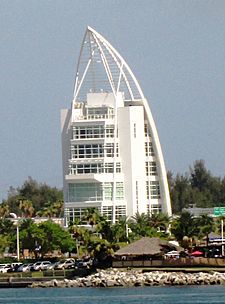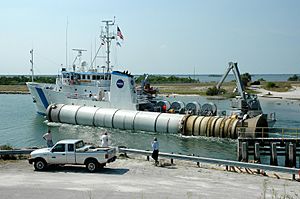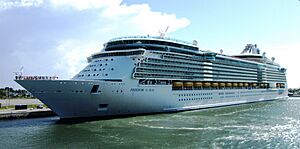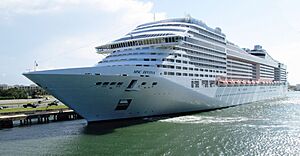Port Canaveral facts for kids
Quick facts for kids Port Canaveral |
|
|---|---|
 |
|
| Location | |
| Country | |
| Location | Brevard County, Florida |
| Details | |
| Opened | 1953 |
| Operated by | Port Canaveral |
| Available berths | 18 |
| Draft depth | 39.5 feet (12.0 m) |
| Statistics | |
| Annual cargo tonnage | 6 million tons |
| Passenger traffic | 4.07 million |
| Website Canaveral Port Authority |
|
Port Canaveral is a busy port in Brevard County, Florida, United States. It handles cruise ships, cargo, and even supports the Navy. In 2022, it was the busiest cruise port in the world. Over 4 million passengers traveled through it that year.
The port also moves a lot of cargo, more than 5.4 million tons each year. This cargo includes things like salt, vehicles, oil products, and building materials. The port has special equipment to load products directly into trucks. Its main channel is about 44 feet (13.4 meters) deep.
Port Canaveral exports fresh citrus fruits and frozen orange juice. It also sends out cement and building materials. The port receives lumber, salt for water softeners, cars, and steel. It helps move items for land, sea, air, and even space travel. About ten ships enter the port every day. These include ships from popular cruise lines like Carnival, Disney, Royal Caribbean, and Norwegian.
Contents
The Canaveral Port Authority manages Port Canaveral. It was created in 1953 by the state government. The Authority has a Board of Commissioners and an Executive Management Team. The Board makes important decisions about money, rules, and how the port operates. The Executive Team handles the daily tasks and administration.
How Are Port Leaders Chosen?
Five Commissioners are on the Board. They are elected by people living in the surrounding areas. Each Commissioner must live in a specific district. However, voters from all five districts choose them.
- District 1 (Kennedy Space Center / Titusville) - Jerry Allender
- District 2 (Area between Titusville and Cocoa and west of the US 1) - Micah Loyd
- District 3 (Cocoa / Rockledge) - Wayne Justice
- District 4 (East of the US 1 and Cape Canaveral) - Bob Harvey
- District 5 (Port Canaveral / Cocoa Beach) - Robyn Hattaway
The Chief Executive Officer (CEO) leads the Executive Management Team. In 2017, the Port Authority had 223 full-time employees.
The port's history can be seen in different stages. These stages include its first construction, big expansions, and how it works today.
Building the Port
People first thought about building a port here in the 1880s. The actual digging to create the port happened between 1951 and 1955. The port officially opened on November 4, 1953. A US Navy ship, the USS McClelland, was part of the opening ceremony.
Noah Butt was the first Chairman of the Canaveral Port Authority. George King became the first port manager in 1954. Fishing boats already used the port. Commercial shipping started the next year with a delivery of cement. In 1955, Tropicana Corporation built a large refrigerated warehouse. This was for storing orange juice before it was shipped out.
Growth of Cruise Ships and Space Support
Cruise ships started coming to the port in 1964. However, cruise traffic was limited for a while after that. In 1965, a lock was built at the port. This lock is part of the Canaveral Barge Canal. The Canaveral Lock is still used today and is managed by the US Army Corps of Engineers.
Throughout the 1960s and 1970s, the port focused on fishing and shipping. New cargo piers and warehouses were built.
Port Canaveral has always helped with NASA projects from the nearby Kennedy Space Center. During the Apollo program, parts of the Saturn V rocket came through the port. More recently, the large fuel tanks for the Space Shuttle were floated into Port Canaveral for each mission. Also, the solid rocket boosters were towed back through the port after being retrieved from the ocean after each launch.
In 1990, Morton Salt began operating at the port. They import salt and produce different types of salt for pools, water softeners, and agriculture.
In the 2010s, SpaceX started using the port for their drone ships. These ships are used to land rocket boosters at sea. In April 2016, the drone ship Of Course I Still Love You brought back the first Falcon 9 booster recovered at sea to Port Canaveral.
A new fuel storage area called Seaport Canaveral was finished in 2010. It has a pipeline that goes to Orlando International Airport.
Cruise Terminal 6 opened in 2012 for Carnival ships. A newer addition to the port is the seven-story Exploration Tower. It has exhibit spaces, interactive displays, and observation decks for visitors.
The Canaveral Pilots Association was started in 1968. These pilots are experts who guide large ships safely in and out of Port Canaveral. They board foreign-flagged ships and some US vessels. While on board, the pilot takes control of the ship's movement. They guide the vessels through the port's channels and basins. The pilots use special pilot boats to get on and off the ships.
Cruise Ship Traffic at the Port
Many major cruise lines use Port Canaveral. These include Carnival, Disney, Norwegian, MSC Cruises, and Royal Caribbean International. Princess Cruises and Celebrity Cruises also started using the port in 2024.
In the early 1980s, the port began to focus more on cruise ships. In 1982, a warehouse was turned into Cruise Terminal 1. The SS Scandinavian Sea was the first cruise ship to make Port Canaveral its home. At first, cruises were simple day trips. Later, the port bought more buildings that became Terminals 2 and 3 in 1983. In 1984, the SS Royale began offering year-round cruises to the Bahamas. A fourth cruise terminal was built in 1986.
In December 2014, Port Canaveral and Royal Caribbean International opened Terminal 1. This new terminal was built to handle very large cruise ships. In 2015, it was announced that the world's largest cruise ship, the Oasis of the Seas, would make Port Canaveral its new home.
Many amazing cruise ships call Port Canaveral their home port. This means they start and end their journeys here.
- Mardi Gras
- Carnival Freedom
- Carnival Liberty
- Carnival Magic
- Disney Fantasy
- Disney Wish
- Norwegian Escape
- Mariner of the Seas
- Independence of the Seas
- Jewel of the Seas
- MSC Meraviglia
- Wonder of the Seas
- Marella Discovery
- Carnival Vista
- MSC Seashore
Some ships visit Port Canaveral as part of their journey, but do not start or end there.
- Adventure of the Seas
- AIDAvita
- Anthem of the Seas
- Carnival Pride
- Enchantment of the Seas
- Grandeur of the Seas
- Mein Schiff 6
- MSC Divina
- Norwegian Bliss
- Norwegian Breakaway
- Norwegian Gem
- Oasis of the Seas
More exciting ships are planned to be based at Port Canaveral in the future:
- Carnival Glory (starting May 2024)
- Utopia of the Seas (starting Summer 2024)
- Carnival Venezia (starting December 2024)
- Caribbean Princess (starting November 2024)
- Celebrity Equinox (starting December 2024)
- Disney Treasure (starting December 2024)
- Norwegian Aqua (starting April 2025)
- Star of the Seas (starting Summer 2025)
- Sky Princess (starting November 2025)
- MSC Grandiosa (starting December 2025)
The Naval Ordnance Test Unit operates the naval part of the port. They have sailors and contractors working there. The Trident Turning Basin supports Navy submarines that carry ballistic missiles. In 2011, the support ship USNS Waters was based at the port.
Port Operations and Size
In 2011, about 75 percent of the cargo handled was fuel. The total amount of cargo increased by 40 percent compared to 2010. The channel leading to the port is 400 feet (122 meters) wide and 3.5 miles (5.6 kilometers) long. Large ships can enter the port at almost any time.
Fun at Jetty Park
The Canaveral Port Authority owns and runs Jetty Park. It's a popular spot for recreation. In 2016, 325,000 people visited the park.
How the Port Affects the Coastline
Ocean currents naturally move sand along the coast. This is called longshore drift. Because Port Canaveral's jetties interrupt this movement, sand builds up north of the port. At the same time, sand erodes from beaches south of the port.
To help with this, the Canaveral Harbor Federal Sand Bypass Project moves sand. It takes sand from the northern beaches and puts it on the southern beaches. This project is a team effort between the Port Authority, the US Army Corps of Engineers, and the State of Florida.
More About Florida Ports
- PortMiami and Port Everglades are other large ports in South Florida. They also handle many cruise passengers.
See also
 In Spanish: Puerto Cañaveral para niños
In Spanish: Puerto Cañaveral para niños






